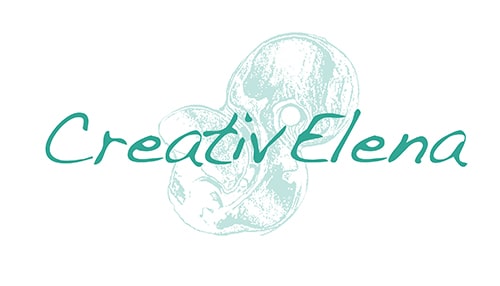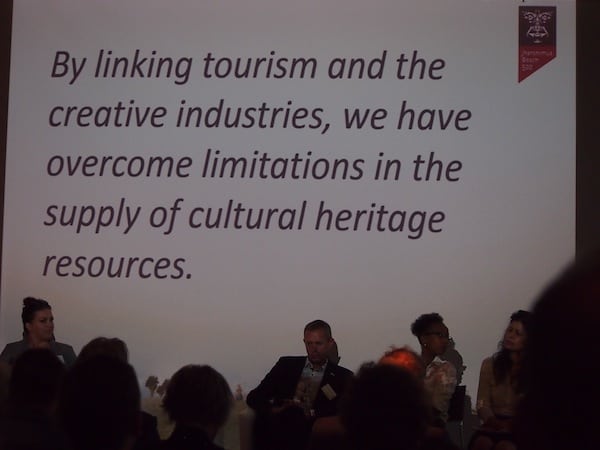My love affair with creative tourism has been going on for almost a decade. I am absolutely, truly and deeply convinced that this form of interactive culture travel is THE “game changer” in understanding contemporary (culture) tourism development, from culturally enlightening food tours all the way to exploring indigenous heritage traditions in countries such as New Zealand. When the Austrian city of Linz, therefore, announced hosting the international OECD Conference on Tourism & The Creative Economy, I just knew I had to be there. And what a pleasure it was to meet again so many like-minded creative tourism professionals, to make new friends and to network & exchange with leading mentors such as Greg Richards, Patrick Bartos or even … national radio moderator Stuart Freeman!
(Dear Stuart, you are my single most favourite radio moderator in the whole wide world: I am such a fan of your witty, intelligent humour on the FM4 morning show and could hardly live without it! What a pleasure to finally meet you here 😀 )

The OECD Conference on Tourism & The Creative Economy also is this: Stuart Freeman, one of my greatest radio idols, suddenly standing next to me! Thank you dear Stuart for being a wonderful moderator to a most interesting conference here in Linz!

The OECD conference kicks off at the Ars Electronica Centre in Linz, presenting one of the organization’s most recent studies on “Tourism and the Creative Economy”.

The city of Linz, thanks to its outstanding Ars Electronica Centre, provides a welcome creative background for this conference with such innovative projcets as the “Deep Space” projection room!
Leaving soon on my creative round the world research trip with the purpose of publishing an international traveller’s handbook on “Creative Travel”, I shall briefly sum up what the OECD conference on Tourism & The Creative Economy discussed and convened about.
Creating the environment for cooperation: Essentials from the OECD study on Tourism & The Creative Economy.
According to a speech provided by Greg Richards, himself a long-term research expert on the development of Creative Tourism internationally, creative tourism has taken off at roughly the same time as the evolvement of the networking society. New sources of value are prevailing, providing tourism & the creative economies with the challenges of linkage, visibility & coordination. As an example, Greg mentions the city of Santa Fe in New Mexico. Their programme SantaFeCreativeTourism.org started off as a top-down, policy development within the local arts commission. Besides being a hub for all artists in Santa Fe, the aim has also been to network and connect directly with the consumers, resulting in the city’s hosting of the first ever International Creative Tourism Conference back in 2008. The direct impact from Creative Tourism in Santa Fe may be small, but compared to what is happening in the city as a whole, more than a million dollars have already been generated in workshop sales to tourists and local residents over the past few years!
What we are facing, according to Greg, really is a “new reality”. Knowledge-based, creative activities are linking producers and consumers through technology, talent & skill, generating meaningful intangible cultural products, creative content and experiences. Already, cultural tourism is being overlaid with this extra creative layer. Consumers thus end up contributing to their own experiences of a place when travelling, requiring new types of resources such as those provided by the Deep Space Ars Electronica in Linz. Talent, skills and creative content are used to turn this unique projection space into a meaningful, intangible cultural experience for travellers from all over the world. As Patrick Bartos confirms, some of the true “game changers” in tourism do come from within the creative industries, such as Twitter, Vine or Facebook media apps as well as international travel communities like Couchsurfing or AirBnB.
The question now is this: How can tourism effectively work with these “game-changing” trends, as opposed to perpetuating fear in collaboration?

Learning from the knowledge of leading experts in the field of tourism & the creative industries (from left to right): Elisabeth Udolf-Strobl, Director General Tourism and Historic Objects at the Federal Ministry of Science, Research & Economy in Austria, Christopher Lindinger, co-director of the Ars Electronica Future Lab, Georg Steiner, Director of the Tourism Office Linz, Alain Dupeyras, Head of Tourism at the OECD, Patrick Bartos, Managing Director of the Creative Region Linz & Upper Austria, as well as Greg Richards, Professor of Leisure Studies at the University of Tilburg in the Netherlands.

View of the conference venue, the Ars Electronica Centre in Linz, from outside crossing the bridge over the Danube river.

In the evening, we even get to watch the presentations of the Prix Ars Electronica at the Bruckner Haus Linz! Thanks again for a wonderful hosting event here.
Best Practice Workshop Sessions of fusing Tourism & The Creative Economy: Some answers, many interesting conclusions and a (bright) outlook of what’s ahead.
Key success factors act like catalysts translating from one creative industry, such as the international art sector, into the local tourism economy and vice versa. Linz itself is an interesting example in this case. It does not look back on a lot of heritage like the other imperial cities of Vienna or Salzburg: Creative industries are especially important here. It is a message passed on to the visitors of Linz, shaping the image of the destination; an image I can only confirm having visited Linz thanks to a recent meet-up of our gathering of Austrian Travel Bloggers. Stakeholders are like musicians in an orchestra: Overall, it needs to be clear what the message, what the “tune” of the city is.
“Tell stories. Identify environments. Attract the creative class. What are the life concepts of these people? We need fundamental research in the social behaviour of the (young) creative class.”
Event-based concepts in cities like Linz need to focus on the interest of the people who want to spend their lives in a creative way. The organization “Creative Austria” for example is now focused on stories: Where are the hotspots where the creative class of Austria likes to gather? From the Lendviertel district in Graz, to the Tabakfabrik in Linz, it is all a question of telling stories. Greg Richards also has this interesting comment to add to the discussion:
“Barcelona does not see tourists as tourists any more, but as temporary citizens. … The boundaries between locals, tourists and (long-term) visitors are becoming increasingly vague, the concept of visitors as ‘temporary citizens’ an interesting point of debate repositioning tourists vis-à-vis locals.”

Martin Sturm, Director of the “OK” Offenes Kulturhaus in Linz, shows an example of a visitor co-creation culture space.

Lianne Duif, Programme Director of the Hieronymus Bosch 500 Foundation and Dieter Hardt-Stremayr, Director of the Graz Tourist Office, talking about their experiences of tourism & the creative economies in different European spaces.

One of the places whose presentation really makes me want to go & explore more in terms of local storytelling is … the city of Pilsen in the Czech Republic, European Culture Capital in the year 2015!

Taking notes and joining the discussion: Creative Buzz at the OECD Conference on Tourism & The Creative Economy!
Summing up, critical success factors for making collaborations in the creative economy & tourism work are …
- Catalysts. Responding to: Challenges. Is it a drop in tourism? A problem in the creative sector? Or an event, such as the European Cultural Capital? Think about what the catalyst in your particular situation is.
- Resources. Without them, nothing will happen. In the past, the well-accepted model of public sector funding cultural initiatives has become well established, but the new situation is more like this: Is it possible to subsidize initiatives with very little or no public sector funding? Does the public sector still need to be involved, like for example in terms of coordination?
- Clear Communication. Why are we developing creative products? Who are we developing them for? What is the market like? Key issues are both the ability to listen as well as the willingness to learn the language of the other.!

Clearly we are “listening & learning the language of the other”: Our team of international OECD conference participans gathering at the local Linz Wine Fest, who I am so happy to have met !! Thank you for all your inspiration, knowledge & support dear Sérgio Guerreiro (Turismo do Portugal) and Alain Dupeyras, Sérgio Arzeni, Jane Stacey, Soo-Jin Kwon & Andrés Roure-Cuzzoni (OECD Paris)! Looking forward to meeting you again soon!



